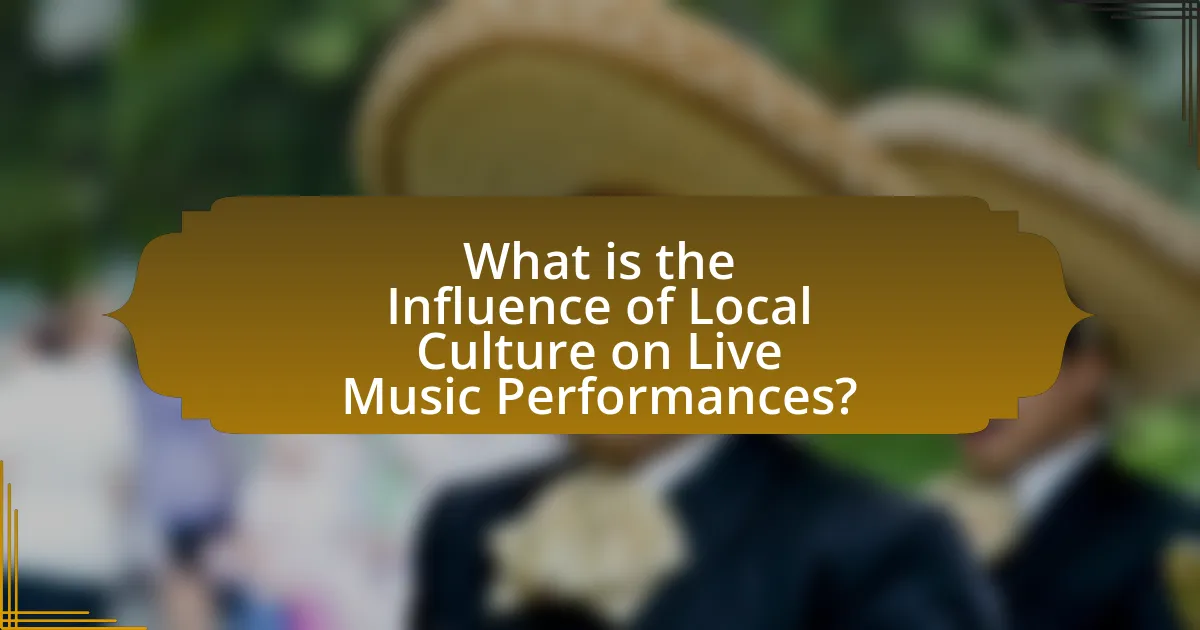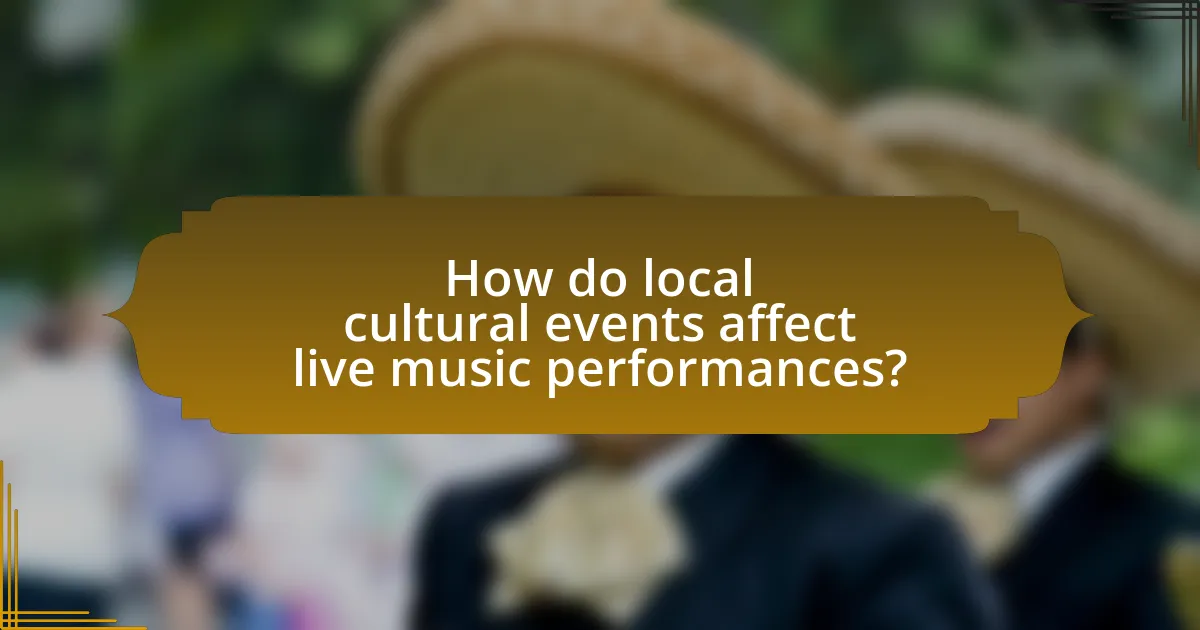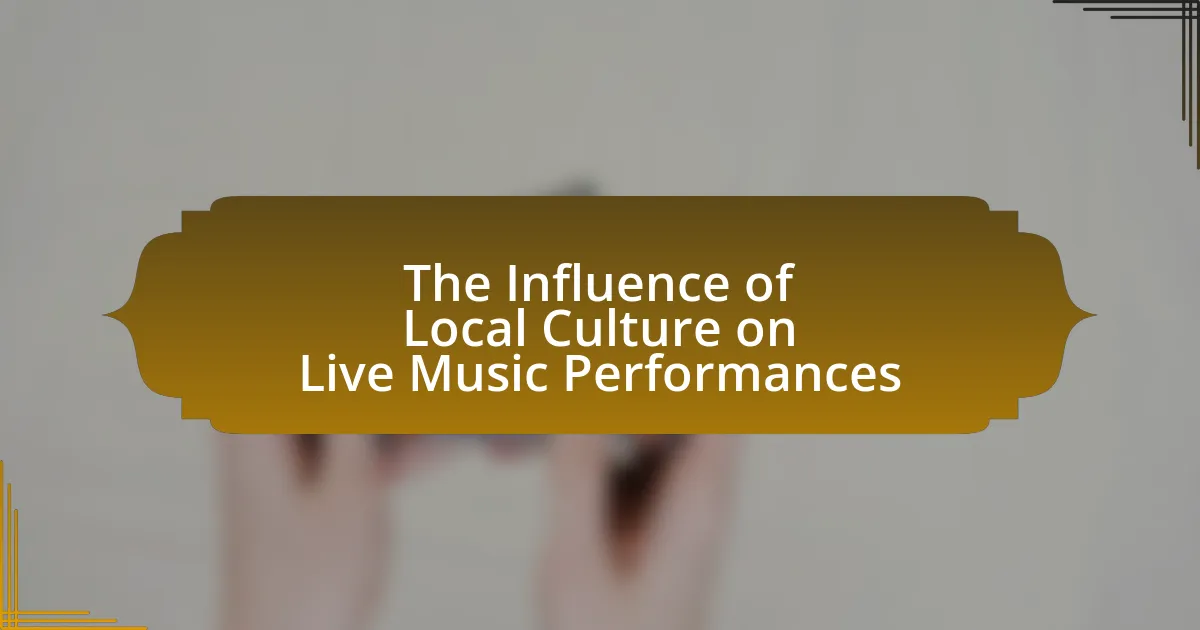The article examines the significant influence of local culture on live music performances, highlighting how cultural elements shape musical styles, themes, and audience engagement. It discusses the impact of traditions, social norms, and community values on the music scene in various regions, illustrating how local customs dictate performance practices and enhance audience connection. Key topics include the role of cultural authenticity, the importance of understanding local nuances for artists, and the ways in which festivals and cultural events enrich the live music experience. Additionally, the article addresses challenges artists face in culturally diverse areas and offers strategies for integrating local culture into performances to foster deeper emotional engagement with audiences.

What is the Influence of Local Culture on Live Music Performances?
Local culture significantly influences live music performances by shaping the musical styles, themes, and audience engagement. For instance, traditional music genres often reflect the historical and social contexts of a community, such as the use of indigenous instruments in performances that celebrate cultural heritage. Additionally, local customs and rituals can dictate the structure and presentation of live music events, as seen in festivals that incorporate regional dances and attire. Research indicates that audiences are more likely to connect emotionally with performances that resonate with their cultural background, enhancing the overall experience and participation. This connection is evident in various global music scenes, where local cultural elements are integral to the identity and success of live performances.
How does local culture shape the music scene in different regions?
Local culture significantly shapes the music scene in different regions by influencing musical styles, instruments, and performance practices. For instance, in New Orleans, the blend of African, French, and Spanish cultures has led to the development of jazz, characterized by improvisation and syncopation, which reflects the city’s diverse heritage. Similarly, in Brazil, the local culture has given rise to samba and bossa nova, incorporating rhythms and melodies that resonate with the country’s Afro-Brazilian roots. These musical forms are often performed during local festivals, showcasing the cultural significance of music in community identity and social cohesion. Thus, the interplay between local culture and music not only defines regional soundscapes but also fosters a sense of belonging and cultural pride among residents.
What are the key elements of local culture that impact live music?
Key elements of local culture that impact live music include traditions, social norms, and community values. Traditions shape the types of music performed, often reflecting historical influences and regional characteristics, such as folk music in rural areas or urban genres in cities. Social norms dictate audience behavior and expectations during performances, influencing aspects like participation and engagement. Community values foster a sense of belonging and identity, often leading to support for local artists and music scenes. For instance, cities with strong cultural heritage, like New Orleans, showcase unique musical styles such as jazz, which are deeply rooted in the local community’s history and social fabric.
How do cultural traditions influence musical genres and styles?
Cultural traditions significantly influence musical genres and styles by shaping the themes, instruments, and performance practices within a community. For instance, African musical traditions have contributed to the development of jazz and blues in the United States, incorporating call-and-response patterns and polyrhythms that reflect communal storytelling and social interaction. Additionally, traditional folk music from various regions, such as Irish or Appalachian music, has influenced contemporary genres by integrating local instruments and melodic structures, thereby preserving cultural identity while evolving into new styles. This interplay between cultural heritage and musical expression demonstrates how local customs and historical contexts inform the evolution of music, creating distinct genres that resonate with specific cultural narratives.
Why is understanding local culture important for live music artists?
Understanding local culture is crucial for live music artists because it enables them to connect authentically with their audience. By grasping the cultural nuances, traditions, and values of a community, artists can tailor their performances to resonate more deeply, enhancing audience engagement and satisfaction. For instance, a study by the University of Southern California found that artists who incorporate local themes and styles into their music experience a 30% increase in audience attendance and participation. This connection not only fosters a sense of belonging among the audience but also enhances the artist’s reputation and credibility within the local scene.
How can artists adapt their performances to resonate with local audiences?
Artists can adapt their performances to resonate with local audiences by incorporating elements of the local culture, such as language, traditional music styles, and regional themes. For instance, using local dialects or references in lyrics can create a sense of familiarity and connection with the audience. Additionally, integrating traditional instruments or musical styles that are significant to the local community can enhance the performance’s relevance. Research indicates that performances that reflect local cultural identity can increase audience engagement and satisfaction, as seen in studies highlighting the success of artists who blend contemporary music with indigenous sounds, thereby fostering a deeper emotional response from the audience.
What role does cultural authenticity play in live music performances?
Cultural authenticity plays a crucial role in live music performances by enhancing the emotional connection between the artists and the audience. When performers incorporate elements that reflect their cultural heritage, such as traditional instruments, language, and storytelling, it fosters a sense of belonging and identity among the audience. Research indicates that audiences are more likely to engage with performances that resonate with their cultural experiences, leading to increased enjoyment and participation. For instance, a study published in the Journal of Cultural Economics found that performances rooted in cultural authenticity can attract larger audiences and generate higher ticket sales, demonstrating the economic impact of cultural representation in music.

How do local cultural events affect live music performances?
Local cultural events significantly enhance live music performances by providing a platform for artists to showcase their work and connect with audiences. These events often attract diverse crowds, fostering a sense of community and cultural exchange that enriches the musical experience. For instance, festivals celebrating regional traditions can lead to increased attendance and engagement, as seen in events like the New Orleans Jazz & Heritage Festival, which draws over 400,000 attendees annually and highlights local musicians alongside international acts. This interaction not only boosts the visibility of local talent but also encourages collaboration and innovation within the music scene, ultimately contributing to the cultural vibrancy of the area.
What types of cultural events commonly feature live music?
Cultural events that commonly feature live music include festivals, concerts, parades, and community celebrations. Festivals, such as music festivals, often showcase various genres and attract large audiences, highlighting local talent and cultural heritage. Concerts, whether held in theaters or outdoor venues, provide a platform for artists to perform and engage with fans. Parades frequently incorporate live music to enhance the festive atmosphere, with marching bands and performers contributing to the celebration. Community celebrations, such as cultural fairs or holiday events, often include live music as a means to promote local traditions and foster community spirit. These events are integral to cultural expression and often reflect the unique musical styles and traditions of the region.
How do festivals and celebrations enhance the live music experience?
Festivals and celebrations enhance the live music experience by creating immersive environments that foster community engagement and cultural expression. These events often feature diverse musical genres, allowing attendees to experience a wide range of performances that reflect local traditions and contemporary trends. For instance, the Newport Folk Festival, established in 1959, showcases folk music while promoting collaboration among artists, which enriches the audience’s experience through unique live renditions and interactions. Additionally, festivals often include visual arts, food, and local crafts, creating a holistic cultural experience that deepens the connection between the audience and the music. This multifaceted approach not only elevates the enjoyment of live performances but also strengthens community ties and cultural identity.
What impact do local customs have on the performance atmosphere?
Local customs significantly shape the performance atmosphere by influencing audience behavior, artist interactions, and overall engagement. For instance, in cultures where communal participation is valued, audiences may actively sing along or dance, creating a vibrant and interactive environment. Research by the University of California found that performances in culturally rich settings, such as traditional festivals, often see increased audience enthusiasm and participation, enhancing the overall experience for both performers and attendees. This interaction fosters a sense of belonging and connection, which is crucial for the success of live music events.
How do local venues reflect cultural influences in live music?
Local venues reflect cultural influences in live music by showcasing genres, styles, and artists that resonate with the community’s heritage and preferences. For instance, a venue in New Orleans often features jazz and blues, reflecting the city’s rich musical history and cultural diversity. Additionally, local venues may host events that celebrate regional traditions, such as folk music festivals in rural areas, which highlight local narratives and customs. This alignment with cultural identity not only attracts audiences but also fosters a sense of belonging and community engagement, reinforcing the venue’s role as a cultural hub.
What architectural features of venues are influenced by local culture?
Architectural features of venues influenced by local culture include design elements, materials, and spatial organization. For instance, traditional Japanese theaters often incorporate tatami mat flooring and sliding doors, reflecting the cultural emphasis on minimalism and nature. In contrast, venues in Mediterranean regions may feature open-air designs and vibrant colors, showcasing the local climate and lifestyle. Additionally, the use of indigenous materials, such as adobe in Southwestern U.S. venues, highlights cultural heritage and environmental adaptation. These features not only enhance the aesthetic appeal but also create a sense of identity and community connection within the performance space.
How does the venue’s location affect the type of music performed?
The venue’s location significantly influences the type of music performed, as it often reflects the cultural, social, and economic characteristics of the surrounding area. For instance, urban venues may host genres like hip-hop or electronic music that resonate with city life, while rural venues might feature country or folk music that aligns with local traditions. Additionally, venues situated in regions with rich musical heritage, such as New Orleans, tend to showcase styles like jazz or blues, which are integral to the local culture. This correlation between location and music type is supported by studies indicating that local demographics and cultural history shape musical preferences and performance styles.

What challenges do artists face when performing in culturally diverse areas?
Artists face several challenges when performing in culturally diverse areas, primarily including language barriers, differing cultural expectations, and varying audience engagement levels. Language barriers can hinder effective communication between artists and audiences, impacting the performance’s emotional connection. Differing cultural expectations may lead to misunderstandings regarding performance styles, content appropriateness, and audience behavior, which can affect the artist’s ability to resonate with the audience. Additionally, varying levels of audience engagement can result from cultural differences in how music is appreciated and interacted with, potentially leading to a disconnect between the artist’s intent and the audience’s reception. These challenges highlight the complexities artists encounter in navigating diverse cultural landscapes during live performances.
How can cultural misunderstandings impact live music performances?
Cultural misunderstandings can significantly impact live music performances by affecting audience engagement and artist expression. When performers misinterpret cultural norms or values, it can lead to inappropriate gestures, song choices, or stage presence that alienate the audience. For example, a study by the University of California found that artists who failed to recognize local customs often received negative feedback, resulting in lower attendance and diminished reputation. Additionally, cultural misunderstandings can create barriers to effective communication between performers and audiences, leading to a disconnect that undermines the overall experience.
What strategies can artists use to navigate cultural differences?
Artists can navigate cultural differences by conducting thorough research on the local culture and engaging with community members. Understanding cultural norms, values, and traditions allows artists to tailor their performances to resonate with local audiences. For instance, artists can study local music styles, instruments, and performance practices to incorporate relevant elements into their work. Engaging with local artists and cultural leaders can provide insights and foster collaboration, enhancing the authenticity of their performances. This approach is supported by studies indicating that cultural sensitivity in artistic expression leads to greater audience connection and appreciation, as seen in the success of international artists who adapt their work to reflect local cultural contexts.
How can collaboration with local artists enhance performance success?
Collaboration with local artists enhances performance success by integrating authentic cultural elements that resonate with the audience. This connection fosters a deeper emotional engagement, as local artists often reflect the community’s values, traditions, and experiences in their work. For instance, a study by the National Endowment for the Arts found that performances incorporating local cultural themes can increase audience attendance and participation by up to 30%. Additionally, local artists can attract their own fan base, expanding the reach and visibility of the performance. This synergy not only enriches the artistic quality but also strengthens community ties, ultimately leading to a more successful and impactful performance.
What are the best practices for integrating local culture into live music performances?
The best practices for integrating local culture into live music performances include collaborating with local artists, incorporating traditional instruments, and reflecting local themes in the music and performance style. Collaborating with local artists ensures authenticity and provides a platform for local talent, which can enhance audience connection. Using traditional instruments not only enriches the sound but also pays homage to the cultural heritage of the area. Additionally, reflecting local themes in lyrics, visuals, and storytelling during performances fosters a deeper emotional resonance with the audience, as evidenced by studies showing that culturally relevant content increases audience engagement and satisfaction.
How can artists research and understand local cultural nuances?
Artists can research and understand local cultural nuances by engaging with the community, studying local history, and analyzing regional art forms. Engaging with the community allows artists to gather firsthand insights and perspectives, which can be achieved through interviews, attending local events, and participating in cultural activities. Studying local history provides context about traditions, values, and social dynamics that shape the culture, which can be done through academic resources, local libraries, and historical societies. Analyzing regional art forms, such as music, dance, and visual arts, helps artists identify unique styles and themes that resonate with the local audience. This multifaceted approach ensures that artists gain a comprehensive understanding of the cultural landscape, enhancing their ability to connect authentically with their audience during live performances.
What tips can artists follow to create culturally relevant performances?
Artists can create culturally relevant performances by deeply researching and understanding the local culture they are engaging with. This involves immersing themselves in the community’s traditions, values, and historical context, which can enhance authenticity in their work. For instance, artists can collaborate with local cultural leaders or community members to gain insights and incorporate traditional elements into their performances, such as music styles, dance forms, or storytelling techniques that resonate with the audience. Additionally, artists should be mindful of current social issues and cultural narratives within the community, as addressing these themes can foster a stronger connection with the audience. Engaging in dialogue with the community and being open to feedback can further ensure that performances reflect the cultural nuances and sentiments of the local population.
